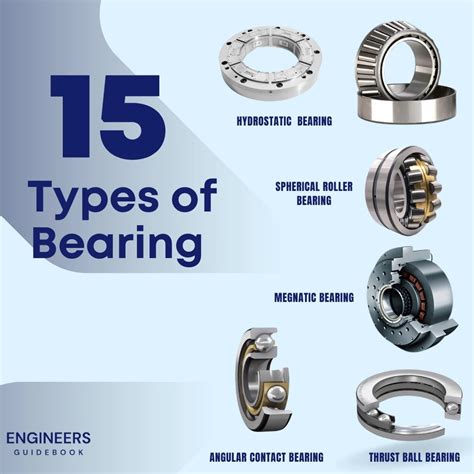Industrial Bearings: The Unsung Heroes of Modern Machinery
Industrial bearings are the unsung heroes of modern machinery, playing a crucial role in enabling smooth operation and maximizing efficiency. These critical components support rotating shafts and reduce friction, ensuring that machines function seamlessly and reliably. In this comprehensive guide, we delve into the world of industrial bearings, exploring their types, applications, and maintenance strategies.
Types of Industrial Bearings
Industrial bearings come in various types, each designed for specific applications and load requirements.
Rolling Element Bearings
-
Ball bearings: The most common type, featuring balls that roll between inner and outer races.
-
Roller bearings: Utilize cylindrical or tapered rollers instead of balls, providing higher load capacity.
-
Needle bearings: Compact bearings with long, thin rollers, ideal for applications with limited space.
Plain Bearings
-
Bushings: Solid or lined cylindrical bearings that provide sliding support for shafts.
-
Sleeve bearings: Similar to bushings, with a thin layer of material between the shaft and bearing.
Other Types
-
Linear bearings: Used for linear motion applications, such as slides and guides.
-
Magnetic bearings: Utilize magnetic fields to levitate shafts, providing very low friction and high speeds.
Applications of Industrial Bearings
Industrial bearings find applications in a wide range of industries and machinery, including:
-
Automotive: Transmissions, engines, pumps
-
Industrial: Motors, generators, conveyors
-
Aerospace: Aircraft engines, landing gear
-
Medical: Surgical equipment, imaging devices
-
Construction: Cranes, excavators
Maintenance Strategies for Industrial Bearings
Proper maintenance is essential to ensure the longevity and reliability of industrial bearings. Key maintenance strategies include:

Regular Inspection
- Visually inspect bearings for damage, contamination, or misalignment.
- Monitor vibration and temperature levels to detect potential problems.
Lubrication
- Lubricate bearings as per the manufacturer's recommendations.
- Use the correct lubricant for the specific application and operating conditions.
Replacement
- Replace bearings as necessary, based on inspection results and usage guidelines.
- Consider predictive maintenance techniques to identify potential failures and schedule timely replacements.
Common Mistakes to Avoid
-
Overloading: Avoid exceeding the rated load capacity of bearings.
-
Misalignment: Ensure proper alignment of bearings to prevent premature failure.
-
Contamination: Keep bearings free from dirt, dust, and moisture.
-
Improper lubrication: Use the correct lubricant and follow proper lubrication practices.
-
Neglecting maintenance: Regular inspection and maintenance are crucial for optimal bearing performance.
How to Choose Industrial Bearings
Selecting the right industrial bearings involves considering the following factors:
-
Load requirements: Determine the radial and axial loads the bearing will experience.
-
Speed: Consider the operating speed of the machine and select bearings with appropriate speed ratings.
-
Lubrication: Choose bearings compatible with the available lubrication methods and conditions.
-
Environment: Consider the operating environment, including temperature, humidity, and potential contaminants.
-
Cost: Balance bearing performance and cost to find the most cost-effective solution.
Step-by-Step Approach to Bearing Replacement
-
Safety first: Disconnect power and ensure the machine is stable.
-
Inspection: Remove the old bearing and inspect the shaft and housing for any damage.
-
Cleaning: Clean the shaft and housing thoroughly to remove any contaminants.
-
Lubrication: Apply the recommended lubricant to the new bearing.
-
Installation: Carefully insert the new bearing into the housing.
-
Alignment: Verify proper alignment of the bearing with the shaft.
-
Secure: Fasten the bearing in place as per the manufacturer's instructions.
-
Test: Reassemble the machine and test its operation to ensure proper functioning.
Frequently Asked Questions (FAQs)
Q1: What are the benefits of using industrial bearings?
A1: Industrial bearings reduce friction, increase efficiency, extend equipment life, and improve machine reliability.

Q2: How often should I inspect industrial bearings?
A2: Inspection frequency varies depending on the application and operating conditions. As a general guideline, bearings should be inspected every 3-6 months.

Q3: Can I use any lubricant for industrial bearings?
A3: No, it is crucial to use the correct lubricant recommended by the bearing manufacturer. Using an inappropriate lubricant can damage the bearing.
Q4: What is the lifespan of an industrial bearing?
A4: The lifespan of an industrial bearing depends on various factors, including load, speed, lubrication, and maintenance. With proper maintenance, bearings can last for several years.
Q5: How can I avoid premature bearing failure?
A5: Prevent overloading, ensure proper alignment, avoid contamination, and follow recommended lubrication practices.
Q6: What are the signs of a failing industrial bearing?
A6: Signs of a failing bearing include excessive noise, vibration, heat, and reduced efficiency.
Call to Action
Industrial bearings are essential for the smooth operation and longevity of modern machinery. By understanding the different types, applications, and maintenance strategies, you can ensure optimal performance and extend the lifespan of your equipment. Remember to follow best practices, avoid common mistakes, and seek professional assistance when necessary to keep your bearings running smoothly.

